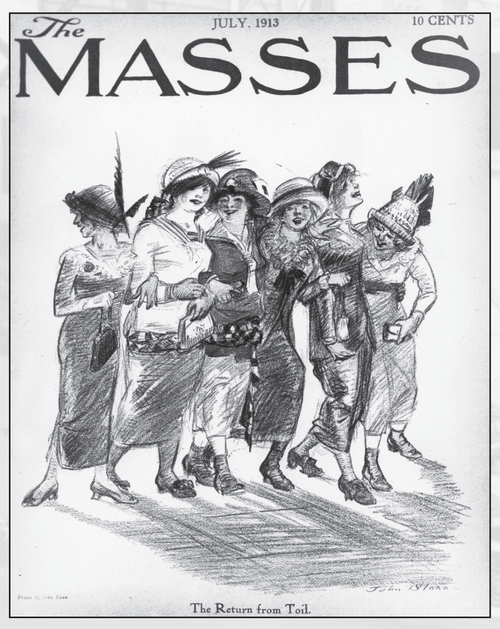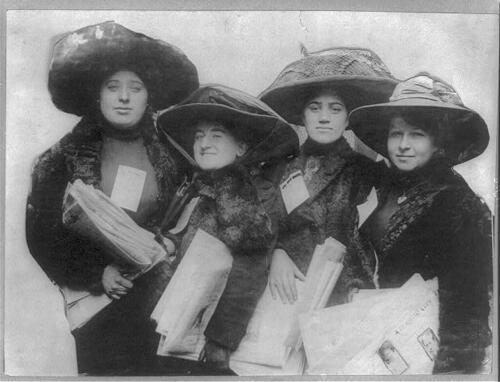Hats and Clothing
"The Return from Toil," July 1913
Courtesy of the U.S. Library of Congress.
Context
Written in 1925, Bread Givers is a novel about the Jewish immigrants who lived in the tenements of New York’s East Side and who worked in the garment industry.
Excerpt from "Bread Givers" beginning “You heartless thing!”
“You heartless thing!” cried Bessie. “No wonder Father named you ‘Empty-Head.’ Here you go to look for work, and you come back with pink roses for your doll face.”
Undisturbed by the bitter words, Mashah finished the last stitch and then hung up her hat carefully over the door.
“I’m going to hear the free music in the park tonight,” she laughed to herself, with the pleasure before her, “and these pink roses on my hat to match out my pink calico will make me look just like the picture on the magazine cover.”
Bessie rushed over to Mashah’s fancy pink hat as if to tear it to pieces, but instead, she tore her own old hat from her head, flung it on the floor, and kicked it under the stove.
Mashah pushed up her shoulders and turned back to the mirror, taking the hairpins carefully from her long golden hair and fixing it in different ways. “It ain’t my fault if the shops are closed. If I take my lunch money for something pretty that I got to have, it don’t hurt you none.”
Excerpt on hats from Clara Lemlich article about 1909 strike
"Sometimes a girl has a new hat. It is never much to look at because it never costs more than fifty cents, but it's pretty sure to be spoiled after it's been at the shop. There are no dressing rooms for the girls in the shops, no place to hang a hat where it will not be spoiled by the end of the day. We’re human, all of us girls, and we’re young. We like new hats as well as any other young women. Why shouldn’t we? And if one of us gets a new one, even if it hasn’t cost more than 50 cents, that means that we have gone for weeks on two-cent lunches—dry cakes and nothing else."
Excerpt about clothing from Sadie Frowne article, "The Story of a Sweatshop Girl"
Some of the women blame me very much because I spend so much money on clothes. They say that instead of a dollar a week I ought not to spend more than 25 cents a week on clothes, and that I should save the rest. But a girl must have clothes if she is to go into high society at Ulmer Park or Coney Island or to the theatre. Those who blame me are the old country people who have old-fashioned notions, but the people who have been here a long time know better. A girl who does not dress well is stuck in a corner, even if she is pretty, and Aunt Fanny says that I do just right to put on plenty of style.
Women Strikers Selling Newspapers circa 1910
Courtesy of the U.S. Library of Congress.
Discussion Questions
- What do you notice about the illustration of the working girls on the cover of The Masses? What conclusions can you draw about the women selling newspapers in the photograph? What do you think they are trying to say about themselves through their clothing?
- What kinds of sacrifices did the character Mashah in Bread Givers, Clara Lemlich, and Sadie Frowne describe making when these working women chose to buy clothing and hat decorations for themselves? Why do you think they were willing to make these sacrifices?
- How were Mashah and Sadie Frowne perceived by others because of their clothes buying?
- What is the real issue behind Clara Lemlich’s demand that the working girls and women have a decent place to hang their hats at work?




